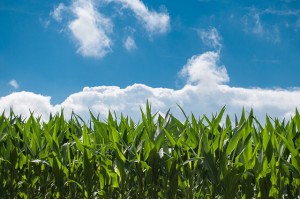 Although sustainability has become the chant of this 21st century, it actually has been something that farmers have been committed to for generations. After all, when you think about sustainable agriculture, growing the right amount of food on less land while using resources efficiently, it’s actually the challenge that farmers manage year after year. The Earth’s precious resources, water and land just to name a couple, are certainly at the forefront of our minds as agriculture conserves for the future.
Although sustainability has become the chant of this 21st century, it actually has been something that farmers have been committed to for generations. After all, when you think about sustainable agriculture, growing the right amount of food on less land while using resources efficiently, it’s actually the challenge that farmers manage year after year. The Earth’s precious resources, water and land just to name a couple, are certainly at the forefront of our minds as agriculture conserves for the future.
About one third of our food results from a honey bee visiting a flower, picking up pollen, and pollinating another flower so that a seed can be fertilized and the plant can produce delicious fruits, berries, nuts and vegetables. Understanding the importance of protecting our pollinators is just the first step. Checkout Tom Dayton’s article BEE Wise in our archives for suggestions of what you can do to help.
Water is a critical lifeline. It sustains our families, our communities, and our planet. 2050 is the year that scientists predict that we will need to double our food supply to meet the world’s growing population. It will be up to all of us to use this precious resource more efficiently and recycle it whenever possible to protect future generations.
When pursuing a productive harvest, a farmer must consider a broad range of soil-related factors including fertility, water retention, nutrient runoff, weeds and pests. But healthy soil does more than just help grow food, it plays a critical role in protecting water quality and reducing erosion.
A popular practice to help reduce erosion is no-till farming. It is the practice of leaving the ground as it is and not disturbing or loosening the soil with tillage. It is a type of conservation tillage that aids in building organic matter for the soil. In 1983, only 17% of all US farmland was in conservation tillage but by 2013, it had risen to 63%.
Once farmers harvest their main crop, they sometimes plant a crop such as grass or a legume, which will cover the field until the next growing season. When you have a cover crop in place instead of an open or bare field, it increases organic matter in the soil, enhances its water holding capacity, and combats the erosion of fertile topsoil. Cover crops also create habitat for wildlife and can attract our pollinators.
The practice of crop rotation, planting different crops in a single field yearly, breaks disease and pest cycles and can assist in building organic matter, as well. About 85% of all corn, soybean and wheat acres are rotated annually in the United States.
Farmers face a number of challenges every year like pests, weather, weeds, and disease. These challenges aren’t just pesky, they can be detrimental to a farmer’s harvest and mean less yield for a farmer and higher food prices for consumers. There’s not one solution that works for all farmers on all fields. Fortunately, today’s farmers have multiple options to achieve sustainable solutions between agriculture and the natural habitats that enrich our work and our world.
Information courtesy of Farm to Plate, Learning How Food Is Grown by Monsanto Company